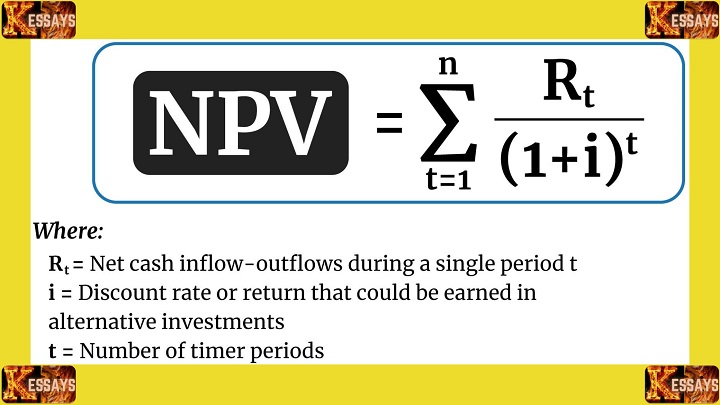Introduction
The Net Present Value (NPV) assignment is a fundamental concept in finance and accounting, serving as a crucial tool for evaluating the financial viability of investments and projects. NPV analysis helps businesses and individuals make informed decisions by assessing the profitability of an investment in today's dollars. In this essay, we will delve into the world of NPV assignments, exploring how to calculate NPV in accounting, NPV formulas with examples, NPV cost considerations, and practical application in
project evaluation.
How do you calculate NPV in accounting?
Calculating NPV in accounting involves assessing the present value of future cash flows generated by an investment or project and comparing it to the initial investment cost. The formula for NPV is as follows:
NPV = Σ [CFt / (1 + r)^t] - Initial Investment
Where:
- NPV represents the Net Present Value.
- Σ denotes the summation of cash flows over each period (t).
- CFt represents the cash flow at a specific time period (t).
- r stands for the discount rate, which reflects the desired rate of return or the cost of capital.
- Initial Investment is the initial outlay required for the investment.

Illustrating the NPV Formula with an Example in a Net Present Value Assignment
In the realm of finance and accounting, the Net Present Value (NPV) assignment plays a pivotal role in evaluating investment opportunities. It involves assessing the profitability of an investment by considering the
present value of expected future cash flows. Let's dive into an illustrative example to grasp the NPV formula in action.
Setting the Stage
Consider a hypothetical project with an initial investment of $50,000. This project is expected to yield annual cash flows for the next five years: $15,000, $18,000, $20,000, $22,000, and $25,000. In this scenario, we assume a discount rate of 10%.
Calculating NPV Step by Step
- Year 1 Cash Flow:NPV = ($15,000 / (1 + 0.10)^1) = ($15,000 / 1.10) ≈ $13,636.36
- Year 2 Cash Flow:NPV = ($18,000 / (1 + 0.10)^2) = ($18,000 / 1.21) ≈ $14,678.18
- Year 3 Cash Flow:NPV = ($20,000 / (1 + 0.10)^3) = ($20,000 / 1.331) ≈ $14,876.71
- Year 4 Cash Flow:NPV = ($22,000 / (1 + 0.10)^4) = ($22,000 / 1.4641) ≈ $14,339.74
- Year 5 Cash Flow:NPV = ($25,000 / (1 + 0.10)^5) = ($25,000 / 1.61051) ≈ $14,620.25
Calculating the Final NPV
Now, let's sum up the individual NPVs and subtract the initial investment:
NPV = $13,636.36 + $14,678.18 + $14,876.71 + $14,339.74 + $14,620.25 - $50,000
NPV ≈ $7,150.24
Interpreting the NPV Result
In this example, the Net Present Value (NPV) assignment yields a positive value of $7,150.24. This positive NPV signifies that the project is expected to generate a net gain of $7,150.24 when the discount rate is 10%. Consequently, this outcome suggests that the project is financially viable, and it is advisable to consider pursuing it.
Understanding and effectively applying the NPV formula is essential in making informed
financial decisions, as it provides valuable insights into the potential profitability of investments and projects.

Understanding NPV Cost: Evaluating Long-Term Expenses
In financial analysis and decision-making, understanding the cost implications of a project or investment is crucial. The Net Present Value (NPV) of Costs, often referred to as NPV Cost, is a formula that enables businesses to assess the financial impact of ongoing costs associated with a project or investment over its lifespan. Let's explore this concept, including the formula and its components, to understand how it facilitates better decision-making in a Net Present Value Assignment.
The Significance of NPV Cost
While traditional NPV analysis primarily focuses on the calculation of cash inflows, NPV Cost takes a different approach. It directs attention to the costs associated with an investment or project, allowing organizations to evaluate the long-term financial burden and make more informed decisions. NPV Cost considers the
time value of money, which means it recognizes that the impact of costs occurring in the future is not the same as their immediate effect.
The Formula for NPV Cost
The formula for NPV Cost is as follows:
NPV Cost = Σ [Costt / (1 + r)^t]
Breaking Down the Formula
- NPV Cost: This represents the Net Present Value of Costs, the key result of the calculation. It indicates whether the ongoing costs associated with a project or investment are financially viable.
- Σ (Sigma): This symbol denotes summation, indicating that you should add up the individual cost values over each period (t). In essence, it accounts for the cumulative impact of costs.
- Cost: This variable represents the cost at a specific time period (t). It could be any period over the project's or investment's lifespan.
- r: This stands for the discount rate, which is consistent with the standard NPV formula. It reflects the organization's required rate of return or cost of capital. It ensures that costs occurring in the future are adjusted to their present value.
Enhanced Decision-Making with NPV Cost
The formula for NPV Cost is a valuable tool for businesses and organizations in making informed financial decisions. By calculating the Net Present Value of Costs, entities can:
- Assess Long-Term Financial Impact: NPV Cost provides a clear picture of the total financial outlay over the project's lifespan, helping organizations prepare for ongoing expenses.
- Consider Time Value of Money: The formula recognizes that a dollar spent in the future has a different value than a dollar spent today, allowing for more accurate financial planning.
- Evaluate Project Viability: By comparing the NPV Cost to the NPV of cash inflows, organizations can determine whether a project or investment is financially feasible or sustainable in the long term.
In conclusion, NPV Cost is a critical component of financial analysis and decision-making. In a Net Present Value Assignment, students learn how to apply this formula to assess the financial impact of ongoing costs, helping them develop the skills necessary for effective financial management and project evaluation.
How to calculate the net present value of a project PDF?
Calculating the Net Present Value (NPV) of a project PDF involves performing the standard NPV calculation but using a probability distribution function (PDF) for cash flow projections. This approach is particularly useful when dealing with uncertain or variable cash flows. To calculate the NPV of a project PDF, you would follow these steps:
- Create a probability distribution for each period's cash flows, considering various scenarios and their associated probabilities.
- For each scenario, calculate the NPV using the standard NPV formula.
- Multiply each scenario's NPV by its corresponding probability.
- Sum the weighted NPVs of all scenarios to obtain the expected NPV.
This approach provides a more realistic assessment of project viability by considering the range of possible outcomes and their associated probabilities.
NPV Accounting Assignment Questions
NPV accounting assignments often include a variety of questions and scenarios designed to test a student's understanding of NPV concepts. These assignments may require students to calculate NPV, assess project profitability, consider different discount rates, or compare multiple investment opportunities. Here are some common NPV accounting assignment questions:
- Calculate the NPV of a project with the given cash flows and discount rate.
- Determine the discount rate required for a project to have a zero NPV.
- Compare two projects with different cash flows and recommend the most financially viable option.
- Assess the sensitivity of NPV to changes in key variables such as cash flows and discount rates.
- Analyze the impact of inflation on NPV calculations.

NPV Accounting Assignment: Developing Financial Analysis Skills
In the realm of finance and accounting education, the Net Present Value (NPV) assignment holds a prominent place. These assignments are designed to challenge students with numerical problems and conceptual questions that pertain to NPV and its diverse applications. Let's delve into the world of NPV accounting assignments to understand their significance in fostering analytical and
decision-making skills in a financial context.
The Role of NPV Assignments
NPV assignments serve as a fundamental component of finance and accounting curricula, playing a pivotal role in preparing students for real-world financial scenarios. They present students with opportunities to apply theoretical knowledge to practical situations, honing their abilities to assess investment opportunities and make informed financial decisions.
Numerical Problem Solving
One key aspect of NPV accounting assignments is the numerical problem-solving component. These assignments require students to calculate NPV for various projects, considering factors such as
initial investments, cash flows, and discount rates. By working through these calculations, students gain hands-on experience in applying the NPV formula and interpreting the results.
Conceptual Understanding
In addition to numerical calculations, NPV assignments often include conceptual questions that challenge students to think critically about the principles and implications of NPV analysis. These questions may explore topics such as the significance of discount rates, the impact of cash flow timing, and the relationship between NPV and project profitability.
Skill Development
Successful completion of NPV assignments contributes significantly to the development of key skills required in accounting, finance, and business management. These assignments foster:
- Analytical Skills: Students learn to dissect complex financial scenarios, identify relevant cash flows, and perform detailed calculations to arrive at NPV figures.
- Decision-Making Skills: NPV assignments require students to make recommendations based on their calculations. This encourages them to consider the financial viability of investments and choose projects that align with organizational goals.
- Communication Skills: Students often need to present their findings and recommendations clearly and concisely, honing their ability to communicate financial information effectively.
- Critical Thinking: The conceptual questions in NPV assignments prompt students to think critically about the underlying principles of NPV analysis and its practical implications.
Career Relevance
For students aspiring to careers in accounting, finance, or business management, NPV assignments are invaluable. These assignments mirror the types of analyses and decision-making processes they will encounter in their professional lives. A strong grasp of NPV is essential for making sound financial decisions, managing investments, and evaluating project feasibility, making NPV accounting assignments a vital component of their educational journey.
In conclusion, NPV accounting assignments are not merely academic exercises; they are practical training grounds for future financial professionals. These assignments equip students with the skills and knowledge needed to navigate the complex world of finance and make informed decisions that can have a profound impact on the success of businesses and organizations.
Net Present Value Examples and Solutions: Evaluating Project Viability
In the world of finance and investment, Net Present Value (NPV) is a crucial tool used to assess the profitability of projects and investment opportunities. In this section, we will delve into a practical example and its solution to illustrate how NPV is calculated and how it informs decision-making.
The Scenario
Imagine a company contemplating a significant investment of $100,000 in a new project. This project is expected to yield annual cash flows over the next five years, with the following amounts: Year 1 - $20,000, Year 2 - $25,000, Year 3 - $30,000, Year 4 - $35,000, and Year 5 - $40,000. The company has established a required rate of return of 12%, and the goal is to determine whether this project is financially viable.
Calculating NPV Step by Step
- Year 1 Cash Flow:NPV = ($20,000 / (1 + 0.12)^1) = ($20,000 / 1.12) ≈ $17,857.14
- Year 2 Cash Flow:NPV = ($25,000 / (1 + 0.12)^2) = ($25,000 / 1.2544) ≈ $19,978.88
- Year 3 Cash Flow:NPV = ($30,000 / (1 + 0.12)^3) = ($30,000 / 1.4049) ≈ $21,185.29
- Year 4 Cash Flow:NPV = ($35,000 / (1 + 0.12)^4) = ($35,000 / 1.5735) ≈ $21,879.91
- Year 5 Cash Flow:NPV = ($40,000 / (1 + 0.12)^5) = ($40,000 / 1.7474) ≈ $22,710.53
Calculating the Final NPV
Now, let's sum up the individual NPVs and subtract the initial investment:
NPV = $17,857.14 + $19,978.88 + $21,185.29 + $21,879.91 + $22,710.53 - $100,000
NPV ≈ $2,832.75
Interpreting the NPV Result
In this example, the Net Present Value (NPV) assignment yields a positive value of $2,832.75. This positive NPV indicates that the project is expected to generate a net gain of $2,832.75 when the discount rate is 12%. Therefore, based on this analysis, it is advisable for the company to proceed with the project.
Understanding and applying NPV calculations is essential for making
informed financial decisions, as it provides valuable insights into the potential profitability of investments and projects. NPV helps organizations allocate resources wisely and prioritize projects that are likely to yield positive returns.

Conclusion
The Net Present Value (NPV) assignment is a valuable tool for evaluating investment and project opportunities in accounting and finance. Understanding how to calculate NPV, using appropriate formulas, and analyzing scenarios are essential skills for making informed financial decisions. NPV assignments provide a practical way for students and professionals to hone their
financial analysis skills, ensuring they can navigate complex financial landscapes and make sound investment choices in both personal and business contexts.




